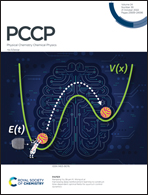Reaction mechanism conversion induced by the contest of nucleophile and leaving group†
Abstract
Direct dynamic simulations have been employed to investigate the OH− + CH3Cl reaction with the chosen B3LYP/aug-cc-pVDZ method. The calculated rate coefficient for the bimolecular nucleophilic substitution reaction (SN2), 1.0 × 10−9 cm3 mol−1 s−1 at 300 K, agrees well with the experimental result of (1.3–1.6) × 10−9 cm3 mol−1 s−1. The simulations reveal that the majority of the SN2 reactions are temporarily trapped in the hydrogen-bonded complex at Ecoll = 0.89 kcal mol−1. Importantly, the influences of the leaving group and nucleophile have been discussed by comparisons of X− + CH3Y (X = F, OH; Y = Cl, I) reactions. For the X = F− reactions, the reaction probability of SN2 increases along the increased leaving group ability Cl < I, suggesting that the thermodynamic factor plays a key role. The indirect mechanisms were found to be dominant for both reactions. In contrast, for X = OH−, the fraction of SN2 drops with the enhanced leaving group ability. In particular, a dramatic transition occurs for the dominant atomic reaction mechanisms, i.e., from complex-mediated indirect to direct, implying an interesting contest between the leaving group and the nucleophile and the importance of the dynamic factors, i.e., the dipole moment, steric hindrance, and electronegativity.



 Please wait while we load your content...
Please wait while we load your content...